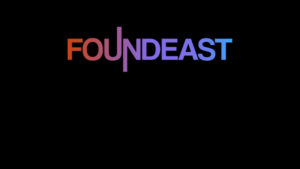Writing copy that generates millions of dollars is easy, right?
You write a bunch of words, and customers pour in.
Eh, not so quick.
Copywriting can look really simple, especially when you read some of the greatest material ever written by the pros.

However, writing copy that produces results for your business or clients is a whole other ballgame.
Besides understanding copywriting strategies and having years of experience under your belt, the process is extremely important, too.
Having a templated writing process will save you time, energy, and allows you to complete projects faster.
Don’t you want that?
Keep reading if so because I’m going to share my secret copywriting process with you today that achieves all of those things.
Step 1: Collect resources and ask the right questions (copywriting research process)
You need to become an expert on a topic or industry as a writer on the fly.
It doesn’t matter if it’s within a couple of hours, days, or weeks.
There are resources you can study to understand any product, audience, and market.
Having this knowledge allows you to write copy that gets customers drooling and begging to buy.
It also helps writers understand what customers want, what they don’t like, and how to speak in their language.
A quote from Stephen King sums this up perfectly:
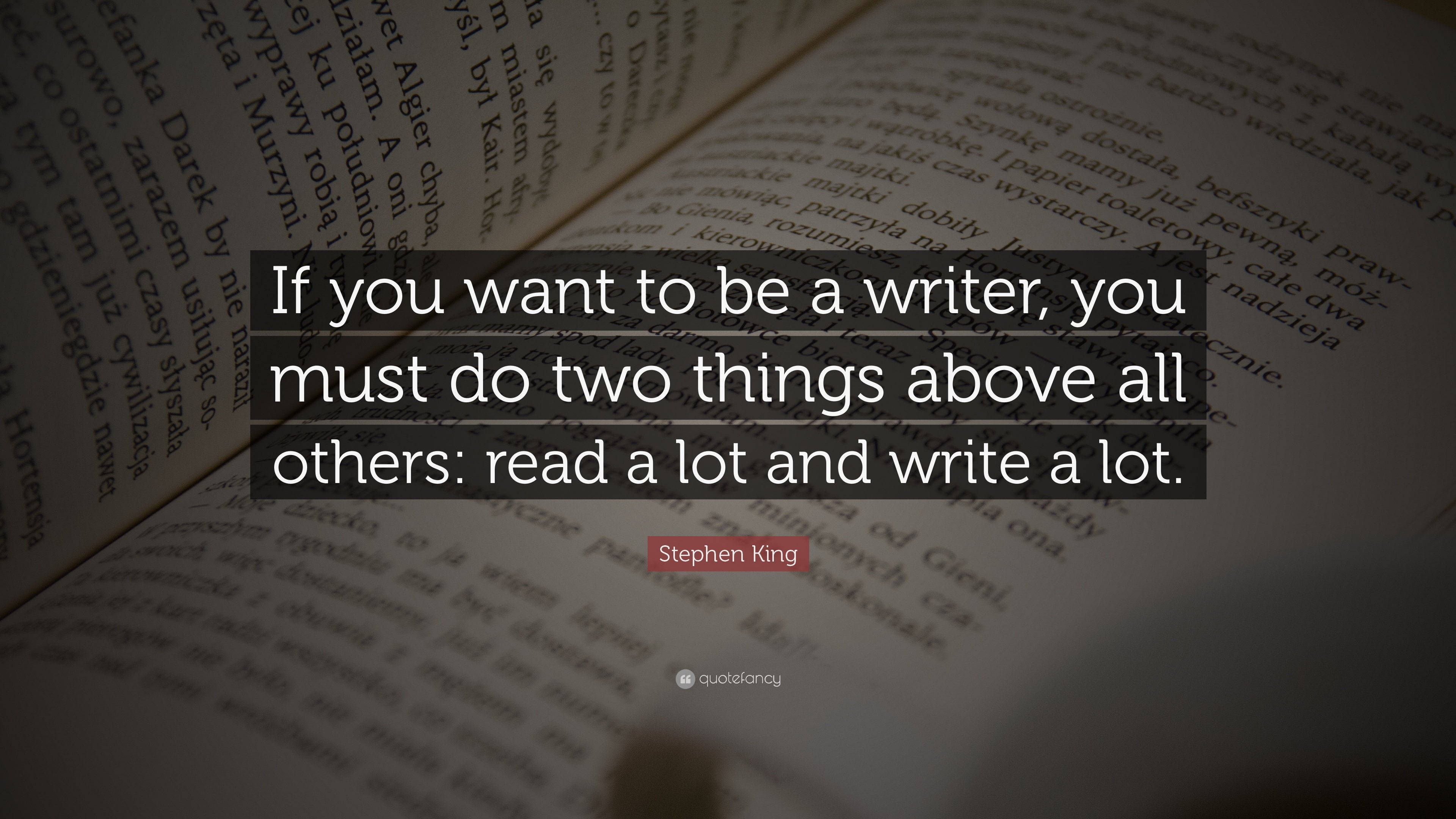
A large part of being a good writer of any sort is reading, practicing writing itself, and researching.
Here are some documents that I recommend writers collect and study before working on a writing project with that being said.
Read reviews to understand customers more deeply
There’s no better way to get into the heads of customers than through reviews and testimonials.
They are literally the customer saying what they like and don’t like.
This allows you to write copy that appeals to what they want while also stimulating pain points and clearing objections as they think them.
Let me give you an example…
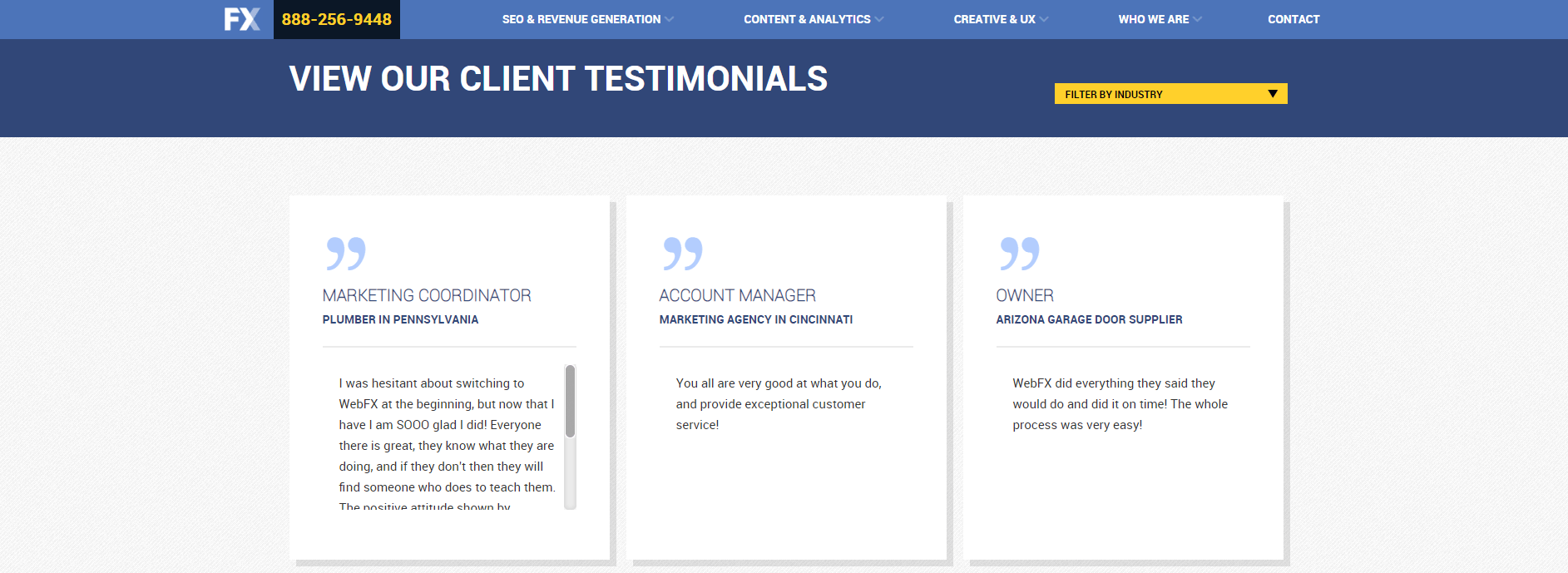
These are the testimonials of a marketing agency called WebFX.
You could scan these reviews to find many different themes like:
- Customers enjoy timely and honest work.
- Projects tailored to the client stood out from cookie-cutter proposals from other businesses.
- They were fun and easy to work with.
These elements can then be incorporated into copy because future customers will be thinking and feeling the exact same things.
I recommend finding several review pages and creating bullet points based on the information you find. You can reference these ideas while you’re writing copy later.
Download industry reports to become an instant expert
Many times I’ve had clients reach out to me, and I knew nothing about their market.
I was practically a NASA scientist in their niche by the end of the night.
How do I pull this off? Industry and market reports.
Imagine being able to download a PDF file that covers any market’s trends, opportunities, consumer behaviours, and future outlooks.
That’s possible with free and paid reports.
Let’s say that you’re working on a writing project for an AI client as an example.
You can search Google for “Artificial intelligence market report,” and there will be mountains of data to collect.
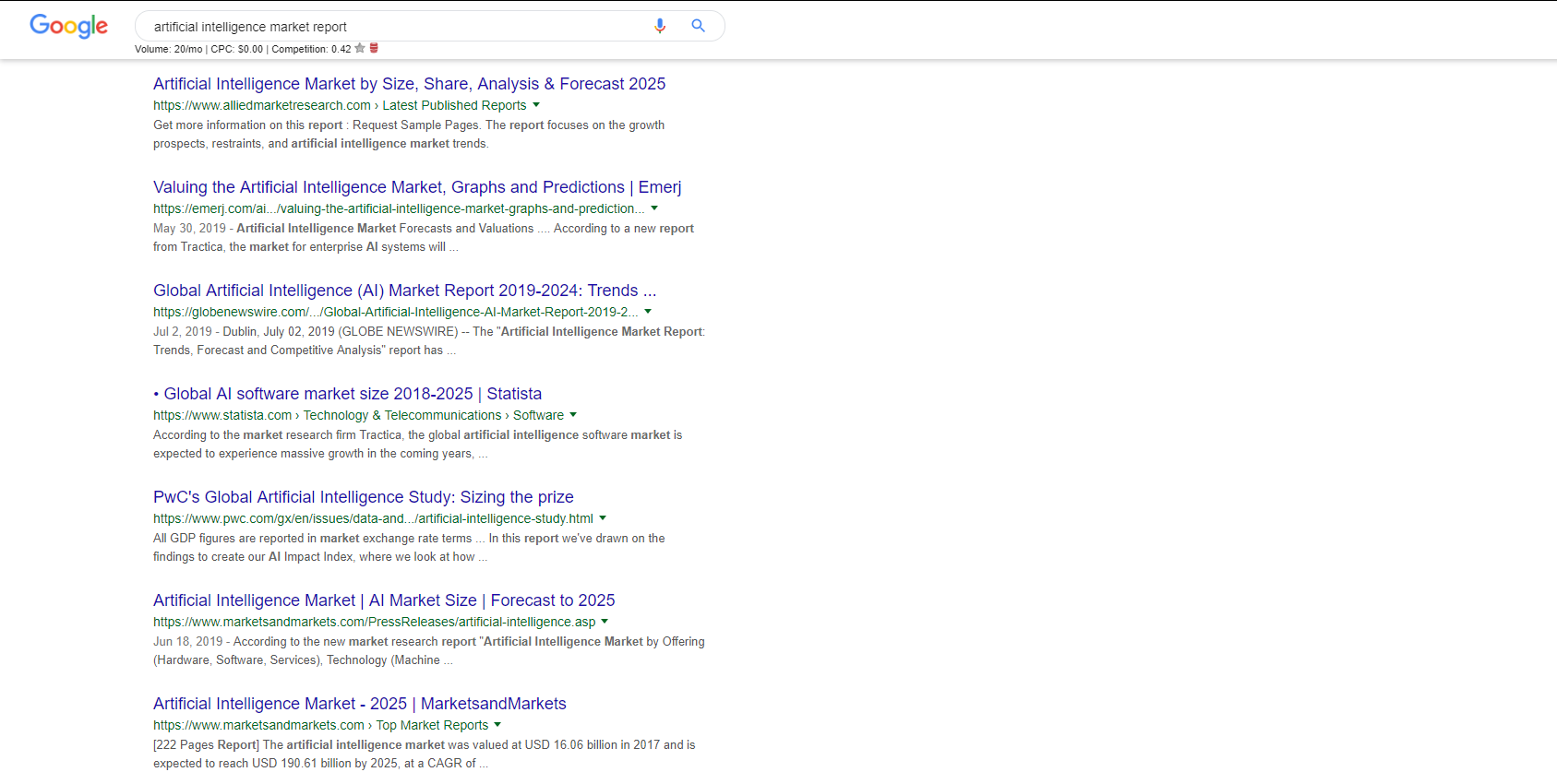
Some reports are free, which is what I recommend you check out.
However, feel free to invest in paid market reports if you want extremely in-depth and proprietary information you won’t find anywhere else.
Using an AI copywriting tool like Jasper is also very helpful when writing about something you have lesser experience with.
Ask for content guidelines and in-house documents
What better way to understand your client’s business than to study their internal memos?
One of the questions I always ask my clients when we begin working together is if they have any content guidelines or similar files for me to read.
These allow me to understand the company’s tone, voice, and how they like to write content.
It also helps me better understand their products, service, and value propositions.
You can constantly reference files like these when writing copy to keep you on track and writing in a consistent manner.
Ask questions about the product
One of the most critical parts of the copywriting process is analyzing the product being promoted inside and out.
I like to ask myself the following questions and write bullets for each one:
- What are the features and benefits?: Features are factual points about a product, while the benefits might be emotional, financial, etc. I wrote a guide on features versus benefits I’d recommend reading to learn more about this idea.
- What’s the unique value proposition?: What makes the product or service stand out among competitors? The client will typically tell you this when you have a discovery call, but it can easily be found on websites and through other promotional material. Find something that makes them stand out if they don’t have a clear UVP.
- What problems does it solve?: Every product and service solves a problem at its root. A content writer like myself helps businesses generate traffic, leads, and revenue without having to write the copy themselves or learn how to do it, for example.
- How much does it cost?: What is the price of the product, and how can you justify it to the audience?
- What’s the turnaround time?: How long will it take for the customer to receive the product? It could be instant if it’s digital, a specific amount of days through the mail, or a predetermined amount of time for services.
- How much does it cost to maintain?: Will the customer need to spend any further money in the future to maintain the product?
- What is the customer trying to get out of it?: Brainstorm the deeper reasons why the customer desires the product.
Ask questions about the audience
After I’ve answered the previous questions about the product, I like to ask myself the following questions about the audience.
If you follow the strategies I outlined before, like studying testimonials and market reports, this will be relatively easy.
- Who are they?: Create a buyer persona with the data you collect. It should include their demographics, pain points, questions, values, feelings, and any other important trait that can be connected to the copy you write.
- Why do they need the product?: Determine what problems they are facing which made them seek the product.
- What purpose does it serve them?: Write bullets on what the product will do for the customer on a daily basis.
- What questions do they have?: What questions would they ask about the product or service? This usually entails pricing, turnaround time, shipping, refunds, etc.
- What objections would they have?: Customers will typically have objections about the product, especially when it sounds too good to be true. Think about these before you write copy because you can solve them as they pop up in their minds.
That sums up the first step of the writing process. Additionally, I would recommend collecting further information on the client’s business and market through:
- Blog posts
- Case studies
- Whitepapers
- Social media conversations
- Forums and discussion boards
You can move on to the first step of writing once you’ve completed this.
Step 2: Write bullets and the first draft
You would have a pile of information and ideas if you followed the strategies I just laid out.
It’s now time to organize them into bullets and write the first draft of the sales copy afterward.
You hear the term bullets all of the time in copywriting. But what makes them so important?
Firstly, it allows writers to quickly come up with ideas and inspiration for the copy.
Secondly, bullets organize different points and sections of the copy.
You can map out the headers of the project first and place bullets under them. When you begin writing that section, you will have plenty of inspiration planned ahead of time.
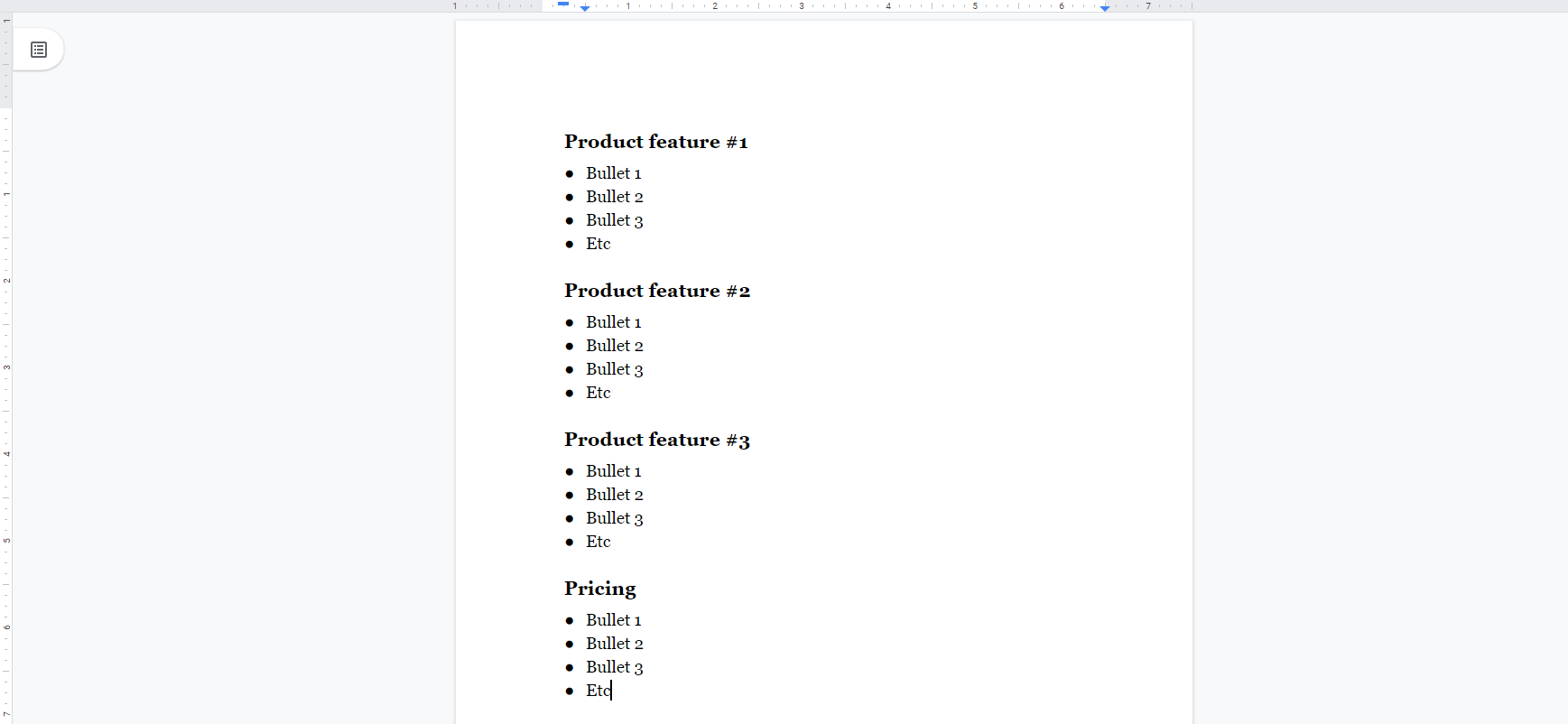
I’m also a firm believer in creating a skeleton of the project before beginning the first draft.
It should look similar to the above in which every header, major point, and the bullet is organized beforehand. This prevents writer’s block because you already know what to write about as soon as you move on to the next section!
You can effectively begin writing the first draft after the skeleton is made. I highly suggest writing the first draft as fast as possible.
I know you might think that quality will suffer, but the opposite is true.
Let me explain.
When you write slowly and analyze everything you’re typing, it uses the non-creative side of the brain.
You might find yourself spending too much time worrying about grammar, flow, logic, etc.
This slows down the writing process tenfold.
On the flip side, when you write very quickly, your brain uses the left hemisphere, which is responsible for emotion and creativity.
You will be revising and editing later, so you don’t need to be a perfectionist.
This is also when I like to write several variations of headlines. I let all of my ideas flow onto the screen.
I like using Jasper to quickly generate copywriting outlines using artificial intelligence. This saves me a ton of time and energy, and I recommend you use it too.
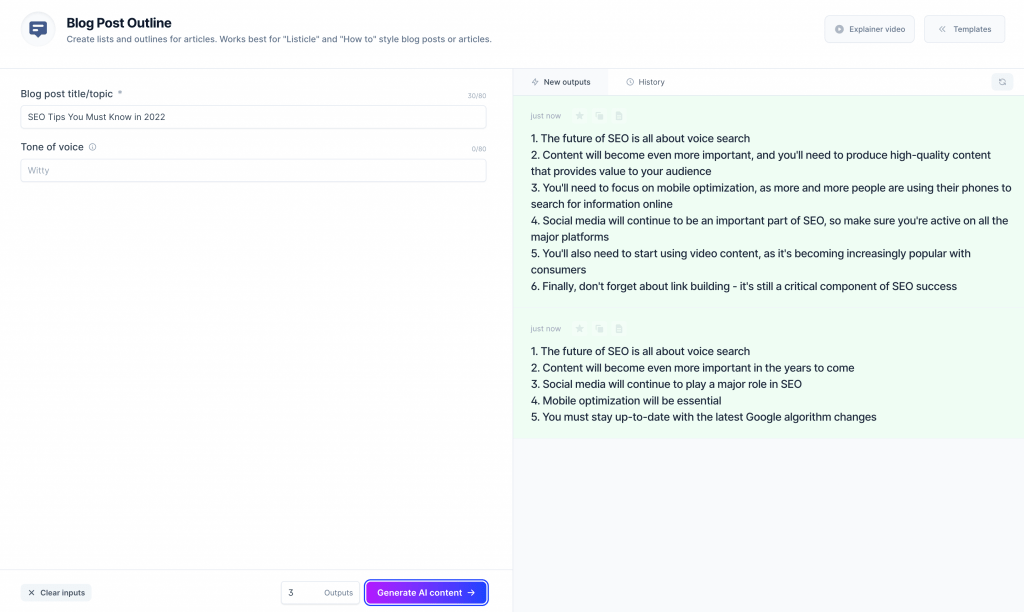
The headline copywriting process
Headlines are the most important parts of advertisements.
Why?
Simply because eight out of ten people only read titles.
If it isn’t exciting, they’ll skip to the next page.
You’re seldom going to nail the headline the first time, either.
Write a few ideas using the following strategies:
- Urgency: Communicate to the reader that if they don’t take action soon, they will miss out on an incredible deal. Or they won’t solve their problem or pain point. (“Only 8 Seats Left For Our Digital Marketing Webinar. Don’t Miss Out!”)
- Curiosity: Don’t give everything away in the headline. Start at the high point of a story or make a bold claim that you explain with the body. (“This Business Model Pays Him $5,500/Day”)
- Benefit-driven: Give readers a direct benefit for reading the sales copy or using the product. (“Learn How to Shed 20 Pounds in The Next 30 Days”)
- Ask a question: Engage the reader with a relevant question that gets them thinking “Yes.” (“Do You Struggle to Generate Leads as a Realtor?”)
- Use a testimonial: Provide social proof by quoting a customer in the headline. (“Carmine’s Copywriting Services Grew Our Business 10x!”)
That brings me to my next point.
Writing subheads
What’s naturally under the headline? The sub-headline!
The goal of subheads is to communicate more value and information, so the person continues reading.
You can use the same strategies used for the main headline itself or try out these methods:
- Product benefits: State one or multiple benefits of the product. (“Increase Your Revenue by 25% The First Quarter”)
- Value proposition: Explain how the reader can’t get the product or service anywhere else. Focus on something proprietary or understated. (“The World’s Only Socks With Six Toes”)
- Guarantee: Provide the guarantee to overcome objections directly in the subhead. (“100% Guaranteed Profits or Your Money Back!”)
- CTA: Tell the reader to continue moving down the page if they want to learn X, Y, Z. (“Keep Reading to Learn How This Remote Village of 3,000 People Has The Secret to Skincare”)
Now we can move on the body.
What should be in the body?
The body copy under each heading and section needs to be tailored to that specific part of the advertisement.
It’ll probably be the most difficult stage in the copywriting process.
I recommend breaking it down part-by-part, so it’s less intimidating.
For example, the introduction might use storytelling to grab people’s attention and get them emotionally invested.
This eventually leads to the product where the features and benefits are listed. A unique value proposition is presented to deposition the competition as well.
The offer, including pricing and how it will change the customer’s life, is summarized.
Then, it’s all wrapped up with a call to action.
This is just a simple example, but you will find body copy easier to write once you have the headline and subheads fleshed out.
Use social proof and credibility
Most consumers look for reviews and testimonials when shopping online.
This plays into the psychology of groupthink.
We innately observe others to make better decisions.
If consumers see that other people enjoy purchasing and using a product, they are significantly more likely to convert.
This is why it’s extremely important to include testimonials alongside sales copy.
These can be either written or video. Kudos if you can get a mix of both.
But don’t stop there.
Turn customers into case studies.
Talk about their experience using the product and what kind of results they generated.
Did they increase their income? Lose a lot of weight? You get my point.
This makes the results more tangible for people reading and emotionally appealing. They’ll experience fear of missing out.
Other ways to create credibility include:
- Using quotes from experts.
- Citing statistics, studies, and data to back up points.
- Using graphs and charts for added context.
- Mentioning awards, education, and certifications.
Form the offer
Next in the copywriting process in advertising is piecing together the offer.
But don’t get it mixed up.
An offer isn’t what you’re selling. It’s what it can do for the customer.
It begins by stating the product or service you’re providing.
Then, talk about the benefits of using it. The emotions they will experience. How it will change their life.
Finally, explain the pricing and guarantee.
These three elements form the offer.
This is a sales letter from Agora Financial for illustration.
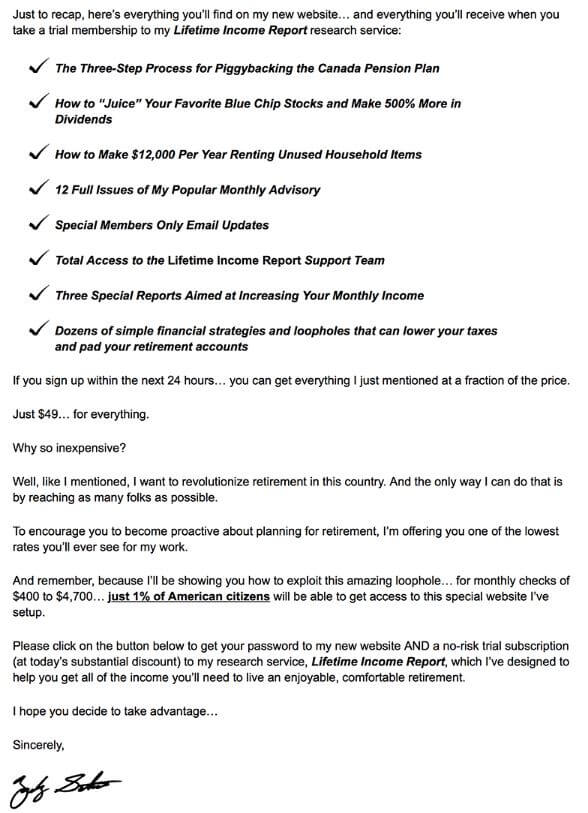
Near the end, Agora summarizes the offer by recapping everything the reader gets out of the paid membership they’re selling.
Note how they use checklist bullet points to make it easy to understand what you’re receiving.
They also translate it into what it will do for customers, such as:
- Lowering taxes.
- Improving retirement accounts.
- Generating more income.
- Etc.
The pricing and steps for ordering are explained afterward.
Write the call to action
While you have will calls to action sprinkled throughout advertisements, there needs to be one main CTA at the end.
This is the big enchilada.
The call to action will drive the majority of responses.
It will change depending on the offer and what you’re trying to achieve.
In general, you’re going to clearly tell the reader to purchase the product, opt into a list, etc.
Here’s another great example from Agora Financial.
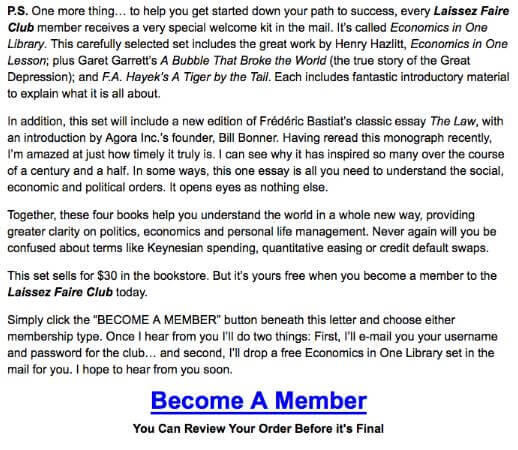
At the end of this sales letter, they use a bold contrasting font with the copy “Become A Member.”
The paragraph above this tells them to “Simply click the “BECOME A MEMBER” button” and choose a membership type.
It’s impossible to miss. Try using different colours, sizing, and graphic instruments to make the CTA jump from the page.
Include a guarantee
Overcoming objections is a huge part of copywriting.
Customers are naturally skeptical and want to protect themselves.
If you can’t prove what you claim, they’ll go purchase from a competitor.
Guarantees are one of the best ways around this.
A guarantee comes in many forms.
It can be a money-back guarantee, satisfaction guarantee, or warranty.
All in all, you’re trying to make the purchase risk-free.
Look at this ad from Duracell for its batteries. They directly state in the headline they offer a 10-year guarantee in storage.

Step 3: Clean up that mess of a first draft
Writing the first draft as quickly as possible is very rewarding.
You get to see a semi-finished product which motivates you to continue the project, and it gives the client something to see.
Although, I would recommend heavily editing it before sending it in for revisions.
The odds are that there will be so many grammar mistakes and errors that it will look like a car wreck.
This is why you should re-read the first draft and fix:
- Grammar and spelling mistakes.
- The logical sequence of points and sections if it makes sense to rearrange them.
- Any unnecessary words or sentences that fluff up the copy.
- Copy that doesn’t ultimately help the goal of the project, such as generating sales or leads.
Something I learned from Dan Kennedy that I think of every time I’m writing is the question, “Does it advance the sale?”
If not, remove it.
I would send the copy in for revisions after editing it to make the client’s life easier and give a better impression.
Revise sections that they wish to see changed and move on to the last step of the copywriting process, which is…
Proofread the heck out of it
You’ve written the first draft. You’ve edited it more than your old college English papers. Now what?
The last step is to proofread the copy to ensure that it’s so perfect you could put it next to the Monalisa, and nobody would tell the difference.
Try giving the copy to friends, family, and other writers to get their feedback.
They may pick up on things you could improve that you didn’t notice before.
I’d also take a look at the information you collected in the first step regarding the product and audience.
Does it completely align with the finished copy? If so, great! If not, rework it.
Summing up the copywriting process
It doesn’t matter if you’re writing direct sales copy, a blog post, or anything in between, the writing process I covered today applies to every kind of material.
Here are the main takeaways that you can apply to your copywriting projects or share with your team:
- Begin by collecting resources like reviews, blog posts, market reports, and content guidelines from the client. Study them to become an expert on their business, industry, and audience.
- Create a skeleton of the project that maps out each major point and place bullets under each of them. Write the first draft as quickly as possible to use the creative and emotional hemisphere of the brain.
- Feel free to sleep on the copy to come back to it with a fresh mind. Edit it afterward to fix grammar mistakes and fluff.
- Proofread the copy to ensure that it aligns with the end goal of the project and customer.
Want to learn my personal copywriting process and get mentorship? Enroll in my copywriting bootcamp.


